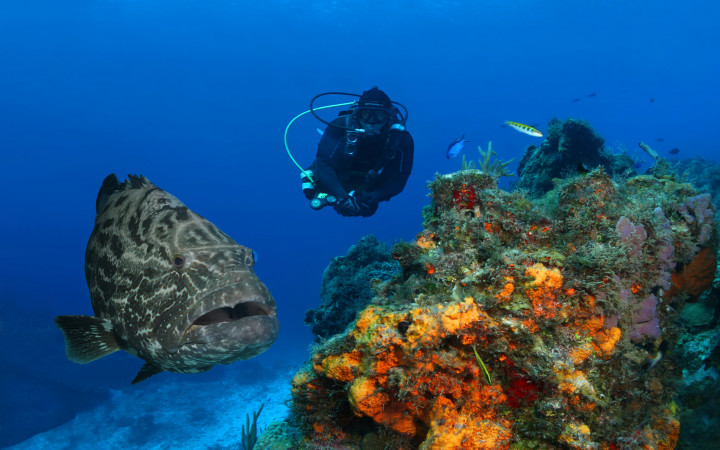Today’s Wonder of the Day was inspired by Jacob from Austin, TX. Jacob Wonders, “What are Goliath Groupers?” Thanks for WONDERing with us, Jacob!
If you’ve been WONDERing with us for a while, you might already know a bit about the food chain. You’ve learned that every habitat has predators and prey. Who’s at the top of the food chain? It depends on which ecosystem you’re talking about.
Take the ocean, for example. Different marine habitats have their own food chains. Algae are eaten by small fish which are then eaten by larger fish. Those larger fish become dinner for even bigger ocean animals, like whales and sharks. But did you know there’s a fish that even some sharks have to look out for?
It’s true! The goliath grouper is able to eat smaller species of sharks. As adults, these giant fish can grow to eight feet long. They can weigh up to 800 pounds! Two species live in the wild today—one in the Atlantic Ocean and another in the Pacific.
Where can you find goliath groupers in the wild? The Atlantic species lives off the coast of western Africa, from Senegal to the Democratic Republic of Congo. They’re also found in waters from the Gulf of Mexico south to the coast of Brazil. The Pacific species can be found in the eastern Pacific Ocean from southern California to Peru.
Young goliath groupers often make their homes among mangroves. Adults prefer coral reefs and other shallow, rocky parts of the sea. The fish are also known to live in or near sunken ships. There, they feed on other fish and invertebrates. Instead of chewing, they’re known to swallow their prey whole.
Goliath groupers may sound intimidating—and for most fish, they are! But humans have little to fear from these creatures. In fact, many people familiar with them call the fish “gentle giants.” It’s still smart to stay away from fully grown goliath groupers. They could eat a person if they wanted to! However, in general, it’s the fish that are threatened by humans, not the other way around.
For many years, people have fished for both species of goliath groupers. In the early 1990s, the Atlantic species was listed as critically endangered. Harvesting the animal for food was banned in the U.S.
Since then, the species has made a comeback, and catch-and-release fishing of the animal is now allowed. The Pacific species is still caught for food by some in Central and South America.
Experts believe goliath groupers are very important to the reef systems they live in. This makes conservation efforts even more important. How do you think we can better protect these giants of the sea?
Standards: NGSS.LS1.C, NGSS.LS2.C, NGSS.ESS3.C, CCRA.L.3, CCRA.L.6, CCRA.R.1, CCRA.R.2, CCRA.R.4, CCRA.R.10, CCRA.SL.1, CCRA.SL.2, NCAS.A.1, NCAS.A.2, NCAS.A.3, CCRA.R.1, CCRA.R.2, CCRA.W.2, CCRA.W.4, CCRA.W.9, CCRA.L.1, CCRA.L.1,




